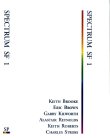Short Fiction
These reviews by Locus Online editor Mark R. Kelly are adapted from his column in Locus Magazine.
|
|
Five Stories for mid-February

Alastair Reynolds, ''Great Wall of Mars''
(Spectrum SF February 2000)
A story in the unfolding future history by this notable new British hard SF writer, whose previous stories include ''A Spy in Europa'' and last year's ''Galactic North'' (both from Interzone), and whose first novel about to be published is Revelation Space (UK: Gollancz, March 2000; reviewed by Gary K. Wolfe and Jonathan Strahan in the March Locus).
The context of this story is an interplanetary conflict between the 'Coalition' of ordinary humans on Earth and the 'Conjoiners', colonists on Mars whose experiments with neural machines have brought about a 'Transenlightenment' that to the Coalition looks like a dangerous hive society. A Conjoiner nest on Mars resides inside the Wall of Reynolds’s title, a huge high-walled ring enclosing a high-atmosphere, partially terraformed environment. A delegation comes to the Conjoiner nest to learn why it persists in futile attempts at escape, and learns the truth of the Conjoiners' existence and plans. This is an exciting, full-bodied story that, among other things, describes the mechanisms and attractions of a hive mind existence better than most stories on the theme.
(Spectrum SF is a new UK bimonthly, edited by Paul Fraser -- website)
§

Jeffrey Ford, ''The Fantasy Writer’s Assistant''
(F&SF February 2000)
A young woman answers an ad for a job as a fact-checker for a popular but personally disagreeable fantasy writer named Ashmolean. After months on the job Ashmolean has a crisis: he says he can no longer “see” his world the way he needs to visualize it so he can write about it. He instructs the assistant to read the manuscript, visualize what will happen next, and tell him, so he can write it down. This she does, with remarkable results. Ford imagines a wry variation on the common writers' claim that their characters become so real, they take over a story and lead it in unexpected directions. Some writers may say they feel manipulated, but Ford suggests that they know exactly what they’re doing.
Paul Di Filippo, ''Stink Lines''
(F&SF February 2000)
An author noted for his insight into pop culture (especially in his ''Plumage from Pegasus'' columns in this magazine) produces one of his most inspired blends of pop culture and SF. The setting is a city that’s been transformed by Disney into Duckburg, a theme park modeled after the work of the 1940s Disney animator who created Scrooge McDuck. A researcher there invents “utility fog”, aerosol nanomachines programmed to project visual enhancements to what people say and feel. In a Disney theme park setting, this means thought balloons that appear in the air when people speak, spinning effects that replace the legs of people running, and wavy lines in ugly colors that depict odors -- in short, the whole iconography of cartoons. Nanotechnology has a bad reputation in SF for being the all-purpose explanation for any desired phenomenon, but surely this is one of its cleverest and most original applications.
§
Orson Scott Card, ''The Elephants of Poznan''
(GalaxyOnline January 2000)
The first story on this new webzine is set in the ancient capital city of Poland in a post-plague world when most of humanity has been wiped out and the few survivors are apparently all sterile. A herd of elephants entering the city heralds the return of Arek, the strange child born of the survivors' early experiments to propogate the species. Now Arek is a prophet, prepared to help his people understand the thoughts of humanity's successor race. Card may be notorious for his controversial religious and moral convictions [see his Salon interview], but he still writes stories that take nothing for granted, stories whose conclusions we cannot predict.
§

Harlan Ellison, ''The Toad Prince or, Sex Queen of the Martian Pleasure-Domes''
(Amazing Stories Special Edition, 600th issue)
An homage to old-fashioned ''star-blasting space adventure'' (in the author’s words), this story is set on a Mars where humans have subjugated the native yellow-skinned ''Marts''. Sarna, an 'imp' or imported prostitute from Earth, stumbles onto a plot to subdue one of ''the Six'', a frog-like creature with seven eyes. As the Marts launch a revolution against their human oppressors, the creature leads Sarna on a quest to reunite itself with its other five parts, a quest whose stakes involve the survival of humanity itself. Ellison spins a grandiose space adventure without postmodern irony or evident parody -- except perhaps for the fairy tale prologue and ending. Will readers 'get' its nostalgic parody of 1940s space opera? In a pop culture saturated by the ''star-blasting space adventure'' of Star Trek and Star Wars, maybe not.




